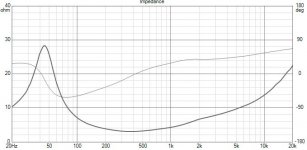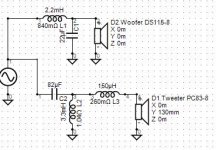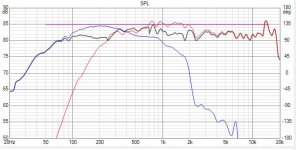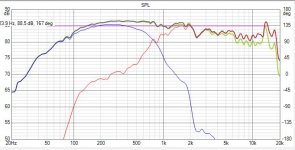Noob Alert!
Designing a crossover for the first time,...using Vituix.
The impedance graph is showing a generated load peaking at 28 Ohm and dipping to 2.8 Ohms, outside the 4-16 Ohm range the amp is rated for.
How concerned should I be?
Have I done this horribly wrong?
Designing a crossover for the first time,...using Vituix.
The impedance graph is showing a generated load peaking at 28 Ohm and dipping to 2.8 Ohms, outside the 4-16 Ohm range the amp is rated for.
How concerned should I be?
Have I done this horribly wrong?
Attachments
Your 'tweeter' needs some attenuation anyway.
Once you fix the overall FR, the impedance should snap into place.
You also have some phase issue below XO point that need to be sorted.
Once you fix the overall FR, the impedance should snap into place.
You also have some phase issue below XO point that need to be sorted.
Your ~28 ohm peak at 46 Hz is normally a function of reflex cabinet tuning -- it has very little, or nothing, to do with the crossover.
L3 is a little unusual. I'd have expected to see another capacitor in that spot.
Regards,
Rick
L3 is a little unusual. I'd have expected to see another capacitor in that spot.
Regards,
Rick
The drivers seem to be out of phase both above and below XO point, actually. Not good. Would try crossing over higher and adjusting XO order. "Tweeter" might need a bit of a shelving filter (e.g. parallel RC in series).
Why combine a 3" fullrange with a 4" mid-woofer anyway? You could easily go with an 8". As a reference of proportions, look at something like the Pioneer CS-5070/7070 (some of the few commercial all-cone speakers that have survived into modern days, not saying that they're good with their thin cabinets and lack of crossovers or damping) - 8" or 10" woofer, 3" midrange, 2.5" tweeter.
Why combine a 3" fullrange with a 4" mid-woofer anyway? You could easily go with an 8". As a reference of proportions, look at something like the Pioneer CS-5070/7070 (some of the few commercial all-cone speakers that have survived into modern days, not saying that they're good with their thin cabinets and lack of crossovers or damping) - 8" or 10" woofer, 3" midrange, 2.5" tweeter.
Your 'tweeter' needs some attenuation anyway.
Once you fix the overall FR, the impedance should snap into place.
You also have some phase issue below XO point that need to be sorted.
That circuit has tweeter attenuation, there's a series inductor. It might not be the right amount, but its definitely attenuation.
It is not clear what you are trying to do here.
What you refer to as the tweeter is crossed over at what would normally be a midrange frequency.
What you refer to as attenuation for the tweeter- that 150uH inductor is I expect trying to address the midrange driver behaving in a very unruly manner at high frequencies.
If you are intending to have a bass / mid system here, that is your choice. I will speak to your original question....
That dip in impedance to 2.8 ohms is no big deal. Don't fuss over the amplifier rating- it is a narrow frequency range and the dip is not that low.
It is z result of the low XO frequency and choice of bass and mid frequencies.
Fwiw.... I would be adding a "conventional" tweeter!
What you refer to as the tweeter is crossed over at what would normally be a midrange frequency.
What you refer to as attenuation for the tweeter- that 150uH inductor is I expect trying to address the midrange driver behaving in a very unruly manner at high frequencies.
If you are intending to have a bass / mid system here, that is your choice. I will speak to your original question....
That dip in impedance to 2.8 ohms is no big deal. Don't fuss over the amplifier rating- it is a narrow frequency range and the dip is not that low.
It is z result of the low XO frequency and choice of bass and mid frequencies.
Fwiw.... I would be adding a "conventional" tweeter!
@sangram
"Your 'tweeter' needs some attenuation anyway."
Is that comment regarding the bump between 600-2khz?
I was focusing on getting the "Reference Angle" graph flat, assumed that was essentially the combined dB.
The sensitivity for both drivers is 85 dB, and they had similar dB peak levels, so didn't seem like I needed to attenuate the tweeter over-all.
"You also have some phase issue below XO point that need to be sorted."
Sorry, don't know what that means.
Can you explain? Others had similar comments about the phase, just don't know what that means / what to do about it.
@Rick PA Stadel
"L3 is a little unusual. I'd have expected to see another capacitor in that spot."
L3 (150uH inductor) is there to flatten 10k-20k otherwise, it was pushing up to 90.2dB at 14kH.
@googlyone
See the response above on the 150uH inductor.
Had these two conventional tweeters on my list:
Dayton Audio DC28F-8
Dayton Audio DC25T-8
will give those a go in Vituix.
Thanks for the responses.
"Your 'tweeter' needs some attenuation anyway."
Is that comment regarding the bump between 600-2khz?
I was focusing on getting the "Reference Angle" graph flat, assumed that was essentially the combined dB.
The sensitivity for both drivers is 85 dB, and they had similar dB peak levels, so didn't seem like I needed to attenuate the tweeter over-all.
"You also have some phase issue below XO point that need to be sorted."
Sorry, don't know what that means.
Can you explain? Others had similar comments about the phase, just don't know what that means / what to do about it.
@Rick PA Stadel
"L3 is a little unusual. I'd have expected to see another capacitor in that spot."
L3 (150uH inductor) is there to flatten 10k-20k otherwise, it was pushing up to 90.2dB at 14kH.
@googlyone
See the response above on the 150uH inductor.
Had these two conventional tweeters on my list:
Dayton Audio DC28F-8
Dayton Audio DC25T-8
will give those a go in Vituix.
Thanks for the responses.
Mark:
The inductor is for response shaping, not attenuation. Attenuation affects the entire passband of the driver, a series inductor in a tweeter circuit only affects part of the passband. A hig-pass Rc filter in an amplifier circuit cannot be called an attenuator either, same logic.
By your logic, every element in the crossover is for attenuation and though at a purely technical level it is correct, the effect is frequency-dependent. Attenuation (to me at least) means an overall reduction.
First off, don't worry about target flat. Target should always slope downward a bit in most cases but I'm assuming this is a FAST-type setup? If so, flat is better as the weaker dispersion of larger drivers at the top end makes up for the brighter on-axis sound. In either case, the inductor will probably not be actually needed.
Phase issues are clearly visible because your drivers are displaying negative summing around the XO point. Which means the summed response is lower than the individual driver response, and this shows up as a 'hole'.
The usual cures are to change the XO order of one of the drivers, change the XO point of one of the drivers, increase or decrease the driver Z-offset, or if all else fails change the driver itself. You either are looking for a nice flat sum at XO with a deep null (20dB or more, ideally) once you reverse one driver polarity. This is the ideal case, you might or might not be able to achieve this with every driver/XO combination.
The mid is significantly louder than it needs to be, and some series resistance will fix the impedance issue as well as bring the level down somewhat.
The inductor is for response shaping, not attenuation. Attenuation affects the entire passband of the driver, a series inductor in a tweeter circuit only affects part of the passband. A hig-pass Rc filter in an amplifier circuit cannot be called an attenuator either, same logic.
By your logic, every element in the crossover is for attenuation and though at a purely technical level it is correct, the effect is frequency-dependent. Attenuation (to me at least) means an overall reduction.
"You also have some phase issue below XO point that need to be sorted."
Sorry, don't know what that means.
Can you explain? Others had similar comments about the phase, just don't know what that means / what to do about it.
First off, don't worry about target flat. Target should always slope downward a bit in most cases but I'm assuming this is a FAST-type setup? If so, flat is better as the weaker dispersion of larger drivers at the top end makes up for the brighter on-axis sound. In either case, the inductor will probably not be actually needed.
Phase issues are clearly visible because your drivers are displaying negative summing around the XO point. Which means the summed response is lower than the individual driver response, and this shows up as a 'hole'.
The usual cures are to change the XO order of one of the drivers, change the XO point of one of the drivers, increase or decrease the driver Z-offset, or if all else fails change the driver itself. You either are looking for a nice flat sum at XO with a deep null (20dB or more, ideally) once you reverse one driver polarity. This is the ideal case, you might or might not be able to achieve this with every driver/XO combination.
The mid is significantly louder than it needs to be, and some series resistance will fix the impedance issue as well as bring the level down somewhat.
So here you enter the territory of opinion and philosophy....
Im not a big fan of using drivers in their breakup region. Yet the full range cohort are.
I will not throw rocks or express overt judgement here. Try this out and see what you think. I would personally go the tweeter. Have a play with any competent unit, and make your own call. Long live DIY.
Im not a big fan of using drivers in their breakup region. Yet the full range cohort are.
I will not throw rocks or express overt judgement here. Try this out and see what you think. I would personally go the tweeter. Have a play with any competent unit, and make your own call. Long live DIY.
@sangram
Thanks for the help, swapped polarity and sloped FR.
Feedback welcome.
I doubt that fixed the problem though.
There are three main issues I can see:
1. that 10mH inductor in the mid circuit looks very wrong for that crossover frequency. There's still no series resistor, which means you're trying to use reactive components for achieving padding - a bad strategy overall wrt system impedance. A bit of a peak in the middle of the crossover region is not a problem (for impedance, not FR) for most any kind of amplifier except maybe some exotic current feedback types, where you would anyway look for high target impedance and then use a zobel on the whole system.
2. the mid is breaking up badly at the top end, it desperately needs a tweeter above 8k. If I were using that unit, I'd cross it at 5 k just looking at the datasheet - which I should have done earlier.
3. I wouldn't cross over anything with Z-offsets in the 400-1k range at all. This means only coaxials can be crossed that low, and I've yet to meet one that can. You will definitely get lobing issues off-axis, and bang in the middle of the vocal range.
Isn't there a Speakers section for such threads?
> load peaking at 28 Ohm and dipping to 2.8 Ohms, outside the 4-16 Ohm range the amp is rated for.
The 28r is Not A Problem. ALL speakers do this. Any audio loudspeaker amp must tolerate it. (It isn't rated for Power in 28r, but we don't need Power when the speaker is resonating.)
<3r for two 8r speakers suggests a b-r-o-a-d overlap where both are working. There are times when this is valid. But the Ten can work to 1kHz pretty well, and at high power the Three may be stressed working to 300hZ. I'd pick the crossover nearer 800Hz to 1.2kHz. And I'd lean to a simple first-order crossover. Maybe 1.5H and 25uFd.
Hi-Fi convention says a Three won't "fill the room" at 20KHz (if it even gets there). We go to a One-Inch tweeter above 2kHz-6kHz so the small source spreads the sound. But IMHO a good Three with a small sofa on-axis can be a fine system. I had a "wide range Twelve" and added a Three, it was quite nice in my chair. It didn't throw highs all around to get lost or echo from kitchen and hallway, very clear.
> load peaking at 28 Ohm and dipping to 2.8 Ohms, outside the 4-16 Ohm range the amp is rated for.
The 28r is Not A Problem. ALL speakers do this. Any audio loudspeaker amp must tolerate it. (It isn't rated for Power in 28r, but we don't need Power when the speaker is resonating.)
<3r for two 8r speakers suggests a b-r-o-a-d overlap where both are working. There are times when this is valid. But the Ten can work to 1kHz pretty well, and at high power the Three may be stressed working to 300hZ. I'd pick the crossover nearer 800Hz to 1.2kHz. And I'd lean to a simple first-order crossover. Maybe 1.5H and 25uFd.
Hi-Fi convention says a Three won't "fill the room" at 20KHz (if it even gets there). We go to a One-Inch tweeter above 2kHz-6kHz so the small source spreads the sound. But IMHO a good Three with a small sofa on-axis can be a fine system. I had a "wide range Twelve" and added a Three, it was quite nice in my chair. It didn't throw highs all around to get lost or echo from kitchen and hallway, very clear.
have a series of alternate driver and crossover designs, would appreciate feedback on, where should I post that?
- Home
- Source & Line
- Analog Line Level
- High Simulated Impedance - Concerned?




